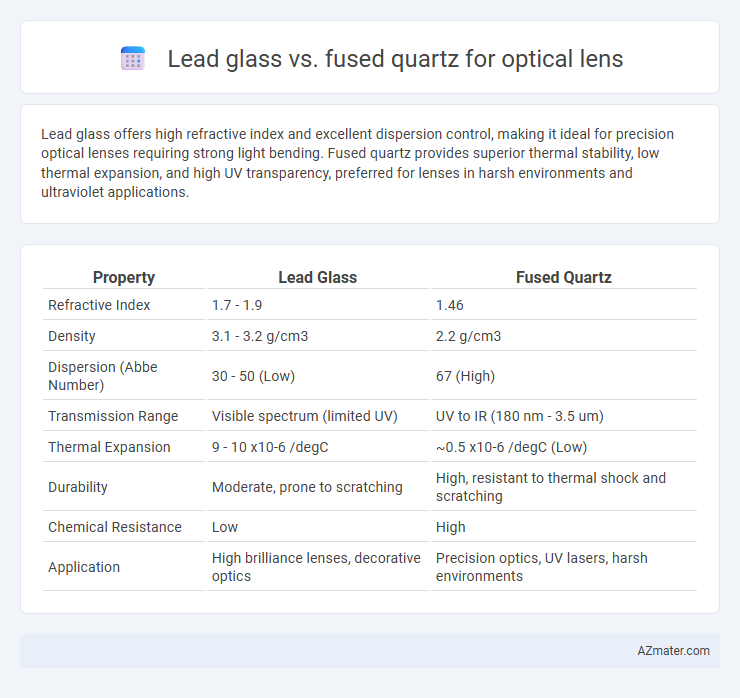Lead glass offers high refractive index and excellent dispersion control, making it ideal for precision optical lenses requiring strong light bending. Fused quartz provides superior thermal stability, low thermal expansion, and high UV transparency, preferred for lenses in harsh environments and ultraviolet applications.
Table of Comparison
| Property | Lead Glass | Fused Quartz |
|---|---|---|
| Refractive Index | 1.7 - 1.9 | 1.46 |
| Density | 3.1 - 3.2 g/cm3 | 2.2 g/cm3 |
| Dispersion (Abbe Number) | 30 - 50 (Low) | 67 (High) |
| Transmission Range | Visible spectrum (limited UV) | UV to IR (180 nm - 3.5 um) |
| Thermal Expansion | 9 - 10 x10-6 /degC | ~0.5 x10-6 /degC (Low) |
| Durability | Moderate, prone to scratching | High, resistant to thermal shock and scratching |
| Chemical Resistance | Low | High |
| Application | High brilliance lenses, decorative optics | Precision optics, UV lasers, harsh environments |
Introduction to Optical Lens Materials
Lead glass offers high refractive index and dispersion, making it ideal for lenses requiring strong light bending and chromatic aberration control. Fused quartz excels in thermal stability, UV transparency, and low thermal expansion, providing durability and clarity in harsh environments. Selecting between lead glass and fused quartz depends on balancing optical performance needs with environmental and wavelength-specific requirements.
Composition of Lead Glass and Fused Quartz
Lead glass, also known as lead crystal, is composed primarily of silica (SiO2) combined with significant amounts of lead oxide (PbO), which enhances its refractive index and density, making it suitable for high-precision optical lenses requiring brilliance and clarity. Fused quartz consists almost entirely of pure silicon dioxide (SiO2) in a non-crystalline amorphous form, offering excellent thermal stability, low thermal expansion, and high transmission in UV to IR wavelengths, ideal for demanding optical applications. The difference in composition results in lead glass having higher dispersion and refractive index, while fused quartz provides superior durability and optical performance under harsh environments.
Optical Transparency and Light Transmission
Lead glass exhibits high optical transparency with excellent light transmission in the visible spectrum, making it ideal for precision optical lenses requiring clarity and brightness. Fused quartz surpasses lead glass in UV transparency, maintaining superior transparency in ultraviolet wavelengths and minimizing light absorption. The choice between lead glass and fused quartz depends on the wavelength range and application needs, with fused quartz favored for UV optics and lead glass preferred for visible light applications.
Refractive Index Comparison
Lead glass exhibits a high refractive index typically ranging from 1.7 to 1.9, making it favorable for lenses requiring strong light bending and enhanced magnification. Fused quartz, with a refractive index around 1.46, provides lower dispersion and superior UV transmission, ideal for precision optical applications. This notable difference in refractive indices influences design choices, where lead glass optimizes light focusing power while fused quartz ensures minimal chromatic aberration.
Dispersion and Chromatic Aberration
Lead glass exhibits higher dispersion due to its elevated refractive index, causing increased chromatic aberration in optical lenses compared to fused quartz. Fused quartz offers lower dispersion and superior optical clarity, minimizing color fringing and enhancing image sharpness. Optical systems requiring precise color correction often prefer fused quartz lenses to reduce chromatic aberration effects.
Mechanical Strength and Durability
Lead glass exhibits lower mechanical strength compared to fused quartz, making it more prone to scratching and breakage under stress. Fused quartz offers superior durability with high resistance to thermal shock and mechanical wear, ideal for demanding optical applications. The enhanced toughness of fused quartz ensures longer lifespan and stability in lenses exposed to harsh environments.
Thermal Stability and Resistance
Lead glass offers moderate thermal stability and can withstand sudden temperature changes to a limited extent but is prone to thermal expansion and possible deformation under high heat. Fused quartz exhibits superior thermal stability with a very low coefficient of thermal expansion, making it highly resistant to thermal shock and maintaining optical clarity under extreme temperature variations. In optical lens applications, fused quartz is preferred for environments requiring high thermal resistance and dimensional stability.
Cost and Availability
Lead glass offers a lower-cost alternative to fused quartz, making it more accessible for budget-sensitive optical lens production. Fused quartz, while significantly more expensive due to its high purity and complex manufacturing process, provides superior optical clarity and durability. Availability of lead glass is widespread, with numerous suppliers, whereas fused quartz is less common and may face longer lead times due to its specialized demand.
Applications in Optical Devices
Lead glass offers high refractive index and excellent dispersion properties, making it suitable for specialized optical lenses in imaging and microscopy applications requiring precise color correction. Fused quartz provides superior UV transparency, thermal stability, and low thermal expansion, which is ideal for high-power laser systems, UV lithography, and precision optical components in scientific instruments. The choice between lead glass and fused quartz depends on the specific optical device's wavelength requirements, thermal conditions, and durability needs.
Conclusion: Choosing the Right Material
Lead glass offers high refractive index and excellent dispersion control, making it ideal for lenses requiring precise light bending and chromatic aberration correction. Fused quartz provides superior thermal stability, UV transparency, and resistance to chemical corrosion, which suits high-power laser optics and ultraviolet imaging systems. Selecting the right material depends on balancing optical performance, environmental resistance, and application-specific wavelength requirements.

Infographic: Lead glass vs Fused quartz for Optical lens
 azmater.com
azmater.com